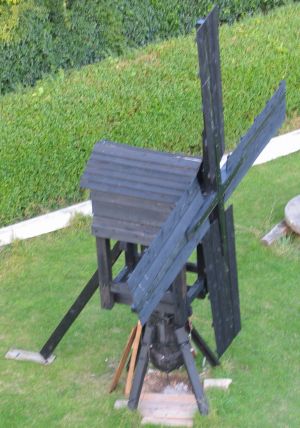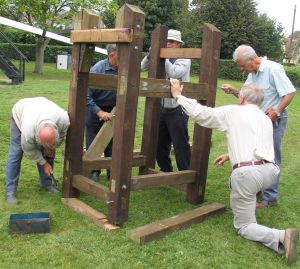Glynde Windpump
Back to Mill Site

The Glynde Wind Pump, also known as the Beddingham Water Pump, was acquired in 2007. It was built, on the Glynde estate, between the river and railway lines between Glynde and Beddingham, around the middle of the 19th century to drain water from flooded lime kilns. After heating the lime, the lime kilns would be flooded by opening sluice gates on a cutting from the river in order to slake the lime. The wind pump was crudely made using materials to hand, including GWR wrought iron railway line as legs. In 1929 a photograph shows it still to be in good condition.
The Sussex Mills Group entry for Glynde Wind Pump incorrectly claims, "Its original purpose was to pump water for two steam engines which drove an aerial rope way bringing gault clay from a quarry two miles away to the Telepherage Company. It drove two lifting pumps with a single throw crankshaft by means of a connecting rod inside the hollow post.". The Telepherage Company was the first to put a motor in each cable-car so that they could independently carry their cargo of clay down to the railway line. However, this system was largely constructed from steel and it is unlikely that the Glynde Wind Pump was built for the stated purpose.
A photograph of 1955 shows that the sails have collapsed. By 1988, the brush has grown up to partly cover the remains of the device.
Restoration
Andrew Norman encountered the rotting remains in the 1980s. He acquired the remains of the pump from Lord Hampden in 1988 and it spent several years in his workshop where he began the restoration. When he moved away from the area, in 2006, High Salvington Mill Trust acquired the pump from Andrew and completed its restoration and installation in the mill field at High Salvington.

When Andrew rescued the remains of the wind pump there was no sign of the original pump that would have been driven by the connecting rods inside the hollow post.
After Andrew sold the device to High Salvington Mill Trust, work resumed on restoring the Glynde Windpump. The hollow post was worked on in the Gatehouse - prior to its conversion to an Archive - with the top of the post fitting through the attic hatch in the ceiling. The body of the pump was worked on in the Roundhouse.
By the East hedge in the Mill field a hole was dug and a blue barrel acquired that was sunk into this hole to act as a reservoir for the pump. As the original pump has never been found at the original site, a Dando “O” pump was acquired, of the type used to drain trenches in WW1.

By March 2008 the restored body of the windpump had been installed on the High Salvington mill field.




On 9th January 1955 Frank Gregory took this photograph (left) of the Glynde Windpump. He notes on the back of the print, "Windshaft with crossing plates - front and back. Remains of tailpost with loop, lying on top."
